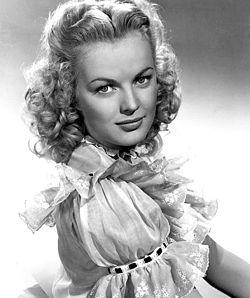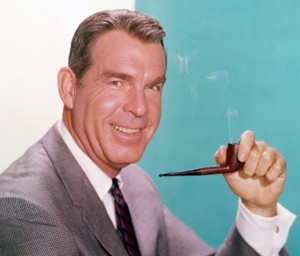Fred MacMurray
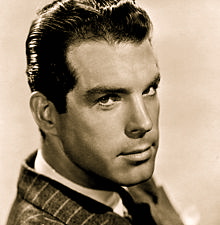
Standing Room Only (1944)
 Frederick Martin MacMurray, born: August 30, 1908 Kankakee, Illinois, U.S. died: November 5, 1991 (aged 83) Santa Monica, California, U.S.
Frederick Martin MacMurray, born: August 30, 1908 Kankakee, Illinois, U.S. died: November 5, 1991 (aged 83) Santa Monica, California, U.S.
Frederick Martin “Fred” MacMurray (August 30, 1908 – November 5, 1991) was an American actor who appeared in more than 100 movies and a successful television series during a career that spanned nearly a half-century, from 1930 to the 1970s.
MacMurray is well known for his role in the 1944 film noir Double Indemnity directed by Billy Wilder, in which he starred with Barbara Stanwyck. Later in his career, he became better known worldwide as Steve Douglas, the widowed patriarch on My Three Sons, which ran on ABC from 1960–1965 and then on CBS from 1965–1972.
Early Life
MacMurray was born in Kankakee, Illinois, to Frederick MacMurray and Maleta Martin, both natives of Wisconsin. When MacMurray was two years old the family moved to Madison, Wisconsin, and later settled in Beaver Dam, Wisconsin, where his mother had been born in 1880. He briefly attended school in Quincy IL. He earned a full scholarship to attend Carroll College (now Carroll University), in Waukesha, Wisconsin. While there, MacMurray participated in numerous local bands, playing the saxophone. He did not graduate from the school.
Career
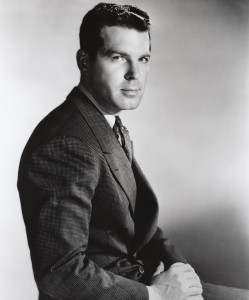 In 1930, MacMurray recorded a tune for the Gus Arnheim Orchestra as a featured vocalist on All I Want Is Just One Girl on the Victor 78 label. Before he signed on with Paramount Pictures in 1934, he appeared on Broadway in Three’s a Crowd (1930–31) and alongside Sydney Greenstreet and Bob Hope in Roberta (1933–34).
In 1930, MacMurray recorded a tune for the Gus Arnheim Orchestra as a featured vocalist on All I Want Is Just One Girl on the Victor 78 label. Before he signed on with Paramount Pictures in 1934, he appeared on Broadway in Three’s a Crowd (1930–31) and alongside Sydney Greenstreet and Bob Hope in Roberta (1933–34).
MacMurray worked with directors Billy Wilder and Preston Sturges and actors Barbara Stanwyck, Humphrey Bogart, Marlene Dietrich and, in seven films, Claudette Colbert, beginning with The Gilded Lily (1935). He co-starred with Katharine Hepburn inAlice Adams (1935), with Joan Crawford in Above Suspicion (1943), and with Carole Lombard in four films: Hands Across the Table (1935), The Princess Comes Across (1936), Swing High, Swing Low (1937), and True Confession (1937).
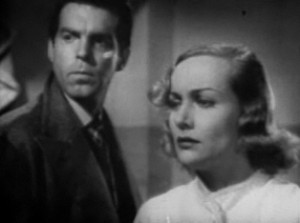 With Carole Lombard in Swing High, Swing Low. (1937)
With Carole Lombard in Swing High, Swing Low. (1937)
Usually cast in light comedies as a decent, thoughtful character (The Trail of the Lonesome Pine 1936) and in melodramas (Above Suspicion 1943) and musicals (Where Do We Go from Here? 1945), MacMurray had become one of Hollywood’s highest-paid actors; for 1943, when his salary reached $420,000, he was the highest-paid actor in Hollywood, and the fourth highest-paid American.
Despite being typecast as a “nice guy,” MacMurray often said his best roles were when he was cast against type by Wilder. He is perhaps best known for his role as Walter Neff, an insurance salesman who plots with a greedy wife Barbara Stanwyck to murder her husband in Double Indemnity (1944). Sixteen years later, MacMurray played Jeff Sheldrake, a two-timing corporate executive in Wilder’s Oscar-winning comedy The Apartment, (1960) with Shirley MacLaine and Jack Lemmon. In another turn in the “not so nice” category, MacMurray played the cynical, duplicitous Lieutenant Thomas Keefer in 1954’s The Caine Mutiny.
In 1958, he guest-starred in the premiere episode of NBC‘s Cimarron City western series, with George Montgomery and John Smith.
MacMurray’s career was revitalized in 1959, when he was cast as the father in the popular Disney Studios comedy, The Shaggy Dog. From 1960 to 1972, he starred in My Three Sons, one of the longest-running television series in the United States. Concurrent with My Three Sons, MacMurray stayed busy in films, starring as Professor Ned Brainard in Disney’s The Absent-Minded Professor (1961) and in the sequel, Son of Flubber (1963). Using his star clout, MacMurray had a provision in his Sonscontract that all his scenes be shot first. This freed him to pursue his film work and golf hobby.
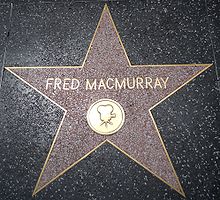 Star on the Hollywood Walk of Fame at 6421 Hollywood Blvd.
Star on the Hollywood Walk of Fame at 6421 Hollywood Blvd.
MacMurray was one of the wealthiest and most frugal actors in the business. Studio co-workers noticed that even as a successful actor, MacMurray usually brought a brown bag lunch to work, often with a hard-boiled egg. According to his co-star on My Three Sons, William Demarest, MacMurray continued to bring dyed Easter eggs for lunch several months after Easter so as not to waste them. Friends and business associates jokingly referred to him as “the thrifty multimillionaire.” Over the years, MacMurray had proven to be a very skillful investor, particularly in California real estate. After the cancellation of My Three Sons in 1972, MacMurray made only a few more film appearances before retiring in 1978.
In the 1970s, MacMurray appeared in commercials for the Greyhound Lines bus company. Towards the end of the decade, he was also featured in a series of commercials for the Korean chisenbop math calculation program.
Personal Life
MacMurray was married twice. He married Lillian Lamont on June 20, 1936, and the couple adopted two children, Susan (b. 1940) and Robert (b. 1946). After Lamont died on June 22, 1953, he married actress June Haver the following year; he and Haver adopted two more children, twins Katherine and Laurie (b. 1956). They remained married until his death.
In 1941 MacMurray purchased land in the Russian River Valley in Northern California and established MacMurray Ranch. He spent time there when not making films, engaging in, among other things, the raising of prize-winning Aberdeen Angus cattle. MacMurray wanted the property’s agricultural heritage preserved, and it was thus sold in 1996 to Gallo, which planted vineyards on it for wines that bear the MacMurray Ranch label. Kate MacMurray, daughter of Haver and MacMurray, now lives on the property (in a cabin built by her father), and is “actively engaged in Sonoma’s thriving wine community, carrying on her family’s legacy and the heritage of MacMurray Ranch.”
He was a staunch supporter of the Republican Party. He joined Bob Hope and James Stewart to campaign for Richard Nixon in 1968.
Death
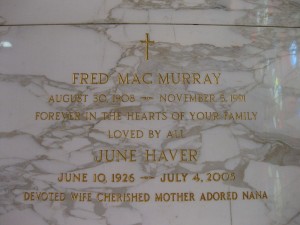 MacMurray and wife June Haver’s grave at Holy Cross Cemetery, Culver City, California
MacMurray and wife June Haver’s grave at Holy Cross Cemetery, Culver City, California
MacMurray suffered from throat cancer in the late 1970s and it reappeared in 1987; he also suffered a severe stroke at Christmas 1988 which left his right side paralyzed and his speech affected, although with therapy he was able to make a 90% recovery.
After suffering from leukemia for more than a decade, MacMurray died frompneumonia in November 1991, aged 83 in Santa Monica. He was entombed in Holy Cross Cemetery. In 2005, his second wife June Haver, aged 79, was entombed with him.
In 1939, artist C.C. Beck used MacMurray as the initial model for the superhero character who became Fawcett Comics‘ Captain Marvel.
MacMurray was nominated for a Golden Globe Award for Best Actor – Motion Picture Musical or Comedy for The Absent-Minded Professor (1961).
MacMurray was the first person honored as a Disney Legend, in 1987.
Filmography – Features

